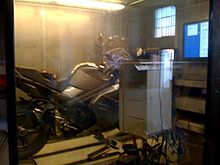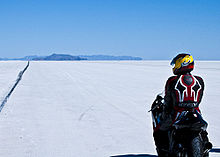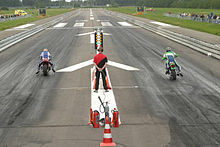- Motorcycle testing and measurement
-
 A Triumph Sprint ST on a chassis dynamometer
A Triumph Sprint ST on a chassis dynamometer
Motorcycle testing and measurement includes a range of more than two dozen statistics giving the specifications of the motorcycle, and the actual performance, expressed by such things as the output of the engine, and the top speed or acceleration of the motorcycle. Most parameters are uncontroversial and claims made by manufacturers are generally accepted without verification. These might include simple measurements like rake, trail, or wheelbase, or basic features, such as the type of brakes or ignition system.
Other measurements are often doubted or subject to misunderstandings, and the motorcycling press serves as an independent check on sometimes unrealistic sales and marketing claims. Many of these numbers are subject to variable methods of measurements, or disagreement as to the definition of the statistic. The parameters most often in contention for motorcycles are the weight, the engine output (power and torque), and the overall performance, especially acceleration, top speed, and fuel economy. With electric motorcycles and scooters, the range between charges is often a pivotal measurement.
Contents
Acceleration and top speed
Two motorcycles at a ¼ mile (402 m) dragstrip.
Motorcycle speed tests, especially at high speeds, are prone to variation due to human error, limitations in equipment, and atmospheric factors like wind, humidity, and altitude. The published results of two otherwise identical tests could vary depending on whether the result is reported with or without industry standard correction factors calculated to compensate for test conditions. Rounding errors are possible as well when converting to/from miles and kilometers per hour.[1]
Engine power and torque
See also: DynamometerReported numbers for horsepower and torque will inevitably vary from one source to another due to inconsistencies in how testing equipment is calibrated, and the method of using that equipment.[2] The horsepower of the engine alone, often called crankshaft power, or power at the crankshaft, will be significantly greater than the horsepower measured at the rear wheel. The amount of power lost due to friction in the transmission and final drive depends on the details of the design and construction. Generalizing, a chain drive motorcycle will have about 20% less power at the rear wheel than at the crankshaft, while a shaft drive model will lose a little bit more than that due to greater friction.
Weight
Motorcycle weight is expressed in three ways: gross vehicle weight rating (GVWR), dry weight and wet weight. GVWR is the maximum total weight of the motorcycle including all consumables, the rider, any passenger, and any cargo. It is generally well-understood and standardized, being defined by law and overseen by agencies such as the US Department of Transportation.[3] In contrast, wet and dry weight are unstandardized measurements that refer to the weight of a the motorcycle without rider, passengers or cargo, and either with (wet) or without (dry) a varying set of fluids such as fuel or lubricants, and the battery.
Wet and dry weight are often used to make comparisons between different motorcycles, because all else being equal, a lighter motorcycle will generally perform and handle better than a heavier one.
The difference between GVWR and wet weight is how much the motorcycle can safely carry, including the rider, and any passenger and their cargo and other accessories. This is especially of interest in touring motorcycles because the greater the difference between GVWR and wet weight, the more gear and supplies may be brought.
Dry weight
The dry weight of a motorcycle excludes some or all of the following: gasoline (or other fuel), engine oil, coolant, brake fluid or battery.
There is no standardized way to test the dry weight of a motorcycle. Inconsistencies will almost always be found between a motorcycle manufacturer's published dry weight and motorcycle press and media outlet's published dry weight. This is due to different testing techniques, differences in what is being excluded, and a lack of defining how testing was conducted by the organization doing the testing. A battery is typically excluded from dry weight by manufacturers but not always by media outlets. Some press and media outlets just exclude fuel to define their dry weight. For a typical sport bike, the difference between wet weight and manufacturer claimed dry weight is around 70 lb (32 kg).[4] This difference includes around 30 lb (14 kg) of gasoline, 7 lb (3.2 kg) of engine oil, 7 lb (3.2 kg) of coolant, and 9 lb (4.1 kg) of battery. These weights are even larger for bigger motorcycles with higher capacities, and attempting to compare the dry weights of air-cooled versus water cooled motorcycles can be misleading.
Hydraulic fluid is not strictly speaking a lubricant, but it is a liquid that might be excluded during shipping. Thus it is not safe to assume that it is either included or excluded. Hydraulic fluid might only be found on a particular bike's front brake with a single line, or could be used on dual front brakes with two lines and one reservoir, plus maybe a rear brake with a reservoir, and also maybe in a hydraulic clutch with its own reservoir, adding a few ounces to a pound or two of uncertainty.
Ducati has in the past used the term "Ducati weight" and given a number close to what media sources have called dry weight.[5]
Beginning in 2009, the four major Japanese manufacturers, and BMW, began publishing the wet weight rather than dry, usually providing some explanation for what this means. Honda describes it as curb weight and says this means the bike is "ready to ride." Others say all fluids are included and the fuel tank is at least 90% full.
Wet weight
The wet weight of a motorcycle includes, but is not limited to fuel, engine oil, coolant, brake fluid, and battery.
There is no global standardized way to test the wet weight of a motorcycle. In the EU, Council Directive 93/93/EEC specifies wet weight as "mass in running order", which includes all equipment normally fitted to a bike such as windscreen, tool kit and at least 90% of its fuel capacity.[6] Motorcycle manufacturers will rarely publish wet weight measurements and inconsistencies will almost always be found between different motorcycle press and media outlets. This is due to different testing techniques, differences in what is being included, and by the organization doing the testing omitting an explanation of how they weighed the motorcycle.
Cycle World has published wet weights with all consumables onboard, but only 1/2 a tank of fuel, while Honda has recently published specification tables that use the typically automotive-oriented term curb weight, and stated that it included full fluid levels and the bike was "ready to ride."
Gross vehicle weight rating
Main article: Gross vehicle weight ratingOther parameters
The following have been commonly used at one time or another to describe motorcycles. Not all of them apply to every motorcycle, and most sources publish only a subset of this list, while others have unique measurements not seen elsewhere.
- Class see types of motorcycle
- Engine see motorcycle engine
- Power see above
- Torque see above
- Bore x stroke
- Compression ratio
- Fuel system
- Lubrication
- Ignition
- Performance
- Top speed see above
- Acceleration: Such as 0 to 60 mph (0 to 97 km/h), 0 to 100 mph (0 to 160 km/h), and roll on acceleration such as 60 to 80 mph (97 to 130 km/h), 80 to 100 mph (130 to 160 km/h)
- 0 to 1⁄4 mi (0 to 0.40 km) See dragstrip
- Braking 60 to 0 mph (97 to 0 km/h), 100 to 0 mph (160 to 0 km/h)
- Fuel consumption See Fuel economy
- Range
- Transmission number of forward gear ratios, and the type of transmission (e.g. "6-speed manual, 5-speed automatic")
- Final drive
- Suspension See Motorcycle suspension
- Brakes
- Tires See Motorcycle tyre
- Dimensions
- Rake and trail
- Wheelbase
- Length
- Width
- Height
- Ground clearance
- Seat height
- Weight
- Dry weight see above
- Wet weight see above
- Gross vehicle weight rating (GVWR)
- Load capacity GVWR - Wet weight
- Fuel capacity
- Oil capacity Typically applies to 2-stroke bikes with a separate oil tank.
- Turning radius
- Climbing ability
See also
- Conversion of units
- Curb weight - the car and truck equivalent of motorcycle wet weight
- Dry weight (automobile)
- Rounding
- Speedometer error
- Vehicle metrics
Notes
- ^ Ford, Dexter (August 2003), "Grudge Match", Motorcyclist (Source Interlink Media): 34–35, ISSN 0027-2205, http://www.motorcyclistonline.com/features/122_0308_kawasaki_zx12r_suzuki_hayabusa/index.html
- ^ Searle, Dave (October 2009), "Measures", Motorcycle Consumer News (Irvine, California: Aviation News Corp) 40 (10): 2, ISSN 1067-8697 1073-9408, 1067-8697, http://www.mcnews.com/mcn/editorials/2009OctOpenRd.pdf, retrieved 2010-04-29
- ^ 390.5: Definitions, Federal Motor Carrier Safety Administration
- ^ Ridden & Reviewed: 2007 Honda CBR600RR
- ^ Ducati M900 i.e. chassis specifications
- ^ "Council Directive 93/93/EEC of 29 October 1993 on the masses and dimensions of two or three-wheel motor vehicles". EUR-Lex. http://eur-lex.europa.eu/LexUriServ/LexUriServ.do?uri=CELEX:31993L0093:EN:HTML. Retrieved 14 December 2009.
References
- Coyner, Dale (2007), The Essential Guide to Motorcycle Travel: Tips, Technology, Advanced Techniques, Kogan Page Publishers, ISBN 1884313590, http://books.google.com/books?id=0KAXtdNSj-4C&pg=PA136&lpg=PA136#v=onepage&q=&f=false
- "Packing: What to take, how to take it", American Motorcyclist (Westerville, Ohio: American Motorcyclist Association) 44 (4): 46, ISSN 0277-9358, http://books.google.com/books?id=F_YDAAAAMBAJ&pg=PA46#v=onepage&q=&f=false
- Stermer, Bill (2006), Streetbikes: Everything You Need to Know, MotorBooks/MBI Publishing Company, p. 37, ISBN 0760323623, 9780760323625, http://books.google.com/books?id=NMokiWY6E00C&pg=PA37#v=onepage&q=&f=false
Categories:- Motorcycle technology
Wikimedia Foundation. 2010.




